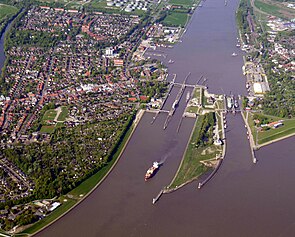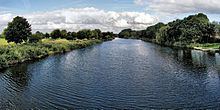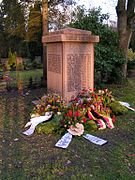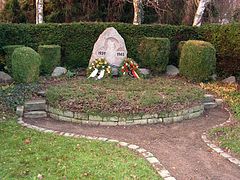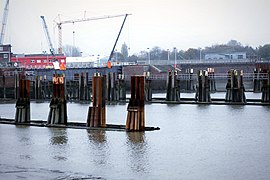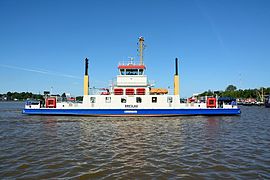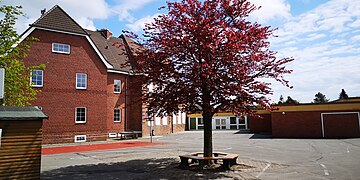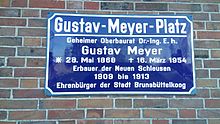Brunsbuettel
| coat of arms | Germany map | |
|---|---|---|

|
Coordinates: 53 ° 54 ' N , 9 ° 8' E |
|
| Basic data | ||
| State : | Schleswig-Holstein | |
| Circle : | Dithmarschen | |
| Height : | 4 m above sea level NHN | |
| Area : | 65.24 km 2 | |
| Residents: | 12,380 (Dec. 31, 2019) | |
| Population density : | 190 inhabitants per km 2 | |
| Postal code : | 25541 | |
| Primaries : | 04851, 04852, 04855 | |
| License plate : | HEI, MED | |
| Community key : | 01 0 51 011 | |
| LOCODE : | DE BRB | |
City administration address : |
Koogstrasse 61–63 25541 Brunsbüttel |
|
| Website : | ||
| Mayor : | Martin Schmedtje (independent) | |
| Location of the city of Brunsbüttel in the Dithmarschen district | ||
Brunsbüttel [ ˈbrʊnsbʏtl ] ( Low German : Bruunsbüddel ) is an industrial and port city in the Dithmarschen district of Schleswig-Holstein . Brunsbüttel is located at the mouth of the Kiel Canal in the Elbe and is the location of the most important seaport on the west coast of the northernmost federal state . The city is best known for the now decommissioned nuclear power plant and the lock systems of the Kiel Canal , the most frequented artificial waterway in the world.
In 1948 Brunsbüttelkoog was granted city rights . After the union with Brunsbüttelkoog and other municipalities in 1970, Brunsbüttel is now in fifth place among the cities of Schleswig-Holstein in terms of area behind Lübeck , Fehmarn , Kiel and Neumünster .
geography
Brunsbüttel lies on the diked river marsh of the Elbe. The urban area has no natural elevations and is only a little above mean sea level. The excavation of the Kiel Canal (1887–1895) and later with the construction of the new locks (1908–1914) resulted in several mounds of earth ( Wurten ) on which the higher parts of the city are today. Brunsbüttel is surrounded and traversed by several, partly economically important, water systems.
Elbe
Brunsbüttel is located approximately at the level of the Elbe -Stromkilometer 695. The Elbe ( Lower Elbe / Lower Elbe ) here forms the estuary during the transition to the Heligoland Bight / German Bight of the North Sea and in the area Brunsbüttel about 3 km wide. The tides here lead to a tidal range of approx. 2.5 to 3 m.
Kiel Canal
The Kiel Canal , inaugurated in 1895, begins in Brunsbüttel (canal km 0) and flows into the Baltic Sea after approx. 99 km near Kiel . It divides the city into an eastern (called Brunsbüttel-Süd) and a western part (called Brunsbüttel-Nord).
Braake
The braake was created when the Elbe dike broke during the Christmas flood in 1717 . Braake means break or broken in Low German. Today it serves as a receiving water for the collection and drainage of surface water and is drained into the Elbe by a pumping station . The Braake takes on further drainage systems in the Brunsbüttel city area (Sprante, Helser - Kattrepeler Fleet) and reaches a width of approx. 40 m here. It is used by the local fishing club and has recently been developed for recreational activities: tennis courts, operation of model ships, public park, open-air dog area.
City structure
The following districts belong to the city of Brunsbüttel:
- Brunsbüttel-North
- Brunsbüttel place
- Brunsbüttel-South
- Blangenmoor-Lehe
- Mill streets
- Osterbelmhusen
- Easter Moor
- Westerbelmhusen
- Westerbüttel
Neighboring cities and larger neighboring towns
|
Marne 10 km |
Heide , Husum 33 km, 65 km |
Burg , Kiel 13 km, 80 km |
|
Cuxhaven 29 km |

|
Wilster , Itzehoe , Lübeck 15 km, 24 km, 101 km |
|
Bremerhaven 53 km |
Hemmoor , Bremen 23 km, 95 km |
Glückstadt , Hamburg 22 km, 68 km |
All information as straight line distance.
history
The oldest written mention of the place can be found in a document dated July 14, 1286. In it, the citizens of Brunsbüttel vowed not to deprive their liege lord, the Archbishop of Bremen Giselbert von Brunkhorst , of Hamburg merchants any more. H. to no longer pursue the beach robbery. The location near the Elbe initially brought the place no luck. After constant land loss, Brunsbüttel was moved inland in the 17th century. The cemetery began in 1654; In 1679 the first service was held in the new St. James' Church. The Christmas flood of 1717 broke deep into the hinterland east of the village. After a setback caused by the New Year's flood in 1721, all efforts to close the dyke led to a long-term dike first with a bypass dike and finally to the dike closure at the break in 1762. The resulting Brunsbüttel-Eddelaker-Koog was given political independence in 1772 by the Danish King Christian VII. When the construction of the Kiel Canal began in 1911, Brunsbüttel was divided. In 1907, the Brunsbüttel-Eddelaker-Koog was renamed Brunsbüttelkoog, the in 1948 received city rights. On January 1, 1970, Brunsbüttelkoog and the communities of Brunsbüttel, Mühlenstrasse, Ostermoor , Osterbelmhusen, Westerbelmhusen (the former parish of Brunsbüttel) and Westerbüttel (the former parish of Eddelak) became the city of Brunsbüttel. Two years later, the municipality of Blangenmoor-Lehe (the former parish of Eddelak) was incorporated as well as an area of about 80 hectares from the neighboring municipality of Büttel in Steinburg , on which a nuclear power plant was built.
During the First World War , the 1st submarine flotilla was stationed in Brunsbüttelkoog.
As a result of the Kiel sailors' uprising , a workers' and soldiers' council was formed in Brunsbüttelkoog on November 5, 1918, similar to the one in Hamburg , Lübeck and Cuxhaven . This made the city one of the places where the November Revolution began.
In the Reichspogromnacht on 9/10 November 1938, the Nazis attacked the Jewish businessman Franz Samter and his son Walter. Both were taken into protective custody. On April 6, 1945 around 8 p.m., a train carrying over 2,000 concentration camp prisoners reached Brunsbüttel station. The guards left the wagons locked until the next morning, despite the catastrophic hygienic conditions. In the night the prisoners raged and screamed in desperation. At least three people were shot dead by the guards. It was not until noon on April 7, 1945 that food was given out and the wagons were poorly cleaned. The train left around 2 p.m.
Incorporations
On April 1, 1934, the parish of Brunsbüttel was dissolved. All of their village communities, village communities and farmers became independent communities / rural communities, including their main town, Brunsbüttel.
On January 1, 1970, the city of Brunsbüttelkoog and the previously independent municipalities of Brunsbüttel, Mühlenstrasse, Osterbelmhusen, Ostermoor, Westerbelmhusen and Westerbüttel were merged to form the new city of Brunsbüttel. On January 1, 1972, Blangenmoor-Lehe was added.
Population development
| date | today's municipality of Brunsbüttel |
former municipality of Brunsbüttel |
Brunsbüttel- koog |
|---|---|---|---|
| December 3rd, 1867 | 3,180 | 1099 | 849 |
| December 01, 1880 | 3,000 | 1061 | 787 |
| December 01, 1890 | 3,955 | 1176 | 1585 |
| December 01, 1900 | 5,950 | 1291 | 3513 |
| December 01, 1910 | 8,530 | 1461 | 5684 |
| 10/08/1919 | 7,850 | 1377 | 5039 |
| 05/17/1939 | 8,051 | 1457 | 5425 |
| 09/13/1950 | 14,407 | 2681 | 9805 |
| 06/06/1961 | 11,997 | 2043 | 8634 |
| 05/27/1970 | 12,225 | ||
| December 31, 2000 | 13,942 | ||
| December 31, 2005 | 13,751 | ||
| December 31, 2010 | 13,120 | ||
| December 31, 2015 | 12,740 | ||
| March 31, 2019 | 12,503 |
politics
Council meeting
Of the 23 seats in the municipal council, the CDU has eight seats since the local elections in 2018, the SPD seven, the FDP four, the Greens three and the WGP (Graue Panther voter initiative) one seat (result of the local election on May 6, 2018).
coat of arms
Blazon : "In red an obliquely left silver wavy bar, which, crossed obliquely to the left, is covered by an anchor with a ring and a spade in confused colors."
The coat of arms was approved for Brunsbüttelkoog in 1951 and taken over by Brunsbüttel after it was founded. The anchor symbolizes the maritime character and the long seafaring tradition of the city. The wavy line and the spade stand for the construction of the Kiel Canal. The motif used in the city flag was designed by the art teacher Wilhelm Horst Lippert .
Town twinning
-
 Horní Počernice , Czech Republic (since February 2004)
Horní Počernice , Czech Republic (since February 2004)
Culture and sights
- Public buildings and facilities
Theaters and museums
The culture and conference center was opened in 1992 after three years of construction. The operator is the Volkshochschule Brunsbüttel e. V.
The Elbeforum Brunsbüttel offers a program of events from the areas of drama, comedy, musical, opera, operetta, cabaret, children's theater and much more. The commercial events in the Elbeforum are also firmly established. a. Balls, meetings, seminars, gatherings, receptions, party conventions and private parties include. The city gallery in the Elbeforum has been run as an art museum since it opened. In addition to maintaining the city's art collection, the city gallery presents a wide-ranging program of changing exhibitions of various art styles.
Every year Brunsbüttel is one of the venues for the Schleswig-Holstein Music Festival . The Elbeforum is the performance location for theater and music events.
Another gallery is the Rusch gallery .
The local museum in Brunsbüttel shows in its collection u. a. the history of the place's origins and introduces the local poet Emil Hecker and the children's book author Boy Lornsen . There are also changing exhibitions on different topics.
The Atrium lock museum provides information about canal construction and locks. The list of cultural monuments in Brunsbüttel includes the cultural monuments entered in the list of monuments of Schleswig-Holstein.
tourism
The biggest attraction in Brunsbuettel is its location on the Lower Elbe and the Kiel Canal , the world's busiest artificial shipping route. The canal locks in particular are not only worth seeing for those interested in ships and technology. In the adjoining Atrium lock museum there are many display boards on the history of the Kiel Canal, models and historical exhibits, such as the imperial pompous tableware for the symbolic laying of the foundation stone and old helmet diving equipment. The construction of the 5th lock chamber - Germany's largest hydraulic construction site - has been attracting technology enthusiasts and trade visitors from all over the world since construction began in 2014. The specially constructed SchleusenInfoZentrum also serves this purpose. The adult education center does not only offer guided tours on the lock area.
There is also a historic town center (Brunsbüttel-Ort) with the Jakobus Church (1677, rebuilt in 1726 after a lightning strike), the local history museum and the Matthias Boie House (1779), which is considered to be one of the most beautiful half-timbered houses in Dithmarschen . In the vicinity of the canal, the official district for the employees of the imperial canal administration was built around 1900, based on the model of English garden cities. The water tower on Ostermoorer Straße, built in 1911, is a cultural monument of particular importance. The Brunsbüttel outdoor pool is located on the dike at the entrance to the new locks of the Kiel Canal. The sunbathing lawn is on the outer embankment and offers a view of the ship traffic. In the recent past, the indoor swimming pool LUV has been extensively modernized and houses a hut village on its premises for group and individual travelers. In spring 2020 it became known that this hut village would be demolished in favor of a new hotel building at the same place. A new mini golf course has been laid out across the street . A parking space with a disposal station for mobile homes rounds off the offer on the street Am Freizeitbad .
Since 2004, the Wattolümpiade , a partly sporty, partly fun competition, has been held annually in the mud flats of the Elbe, in which teams from all over Germany take part. It was started by some committed citizens as a benefit event for the German Cancer Society . The day before the Wattstock Festival takes place. In 2005 the organizers were awarded the German Tourism Prize for innovative tourism projects. The term is an invention of the artist Hein Hoop .
Brunsbüttel is located on the German Ferry Route, which opened in May 2004 . Other holiday routes that run through Brunsbüttel are the Green Coastal Road and the North Sea Coast Cycle Route .
Memorials
To commemorate the victims of both world wars, memorials were erected in several places in the city, where wreaths are laid every year on the day of national mourning by delegations from political and social groups. At the Jakobuskirche there is also a memorial stone for the victims of the Franco-German War (1870/71).
- Memorials in Brunsbüttel
Ostlandkreuz in the Paulus cemetery
The memorial stone for the restoration of the dike in 1762, which was largely destroyed by the Christmas storm flood of 1717, bears the Low German inscription: HIER WOR / DE KOOG SLOTEN / 11.7.1762 (the Koog was closed here).
Economy and Infrastructure
The Brunsbüttel economy is characterized by seafaring and trade. The outstanding date was the opening of the Kaiser Wilhelm Canal (today the Kiel Canal ) in 1895. The pilot brotherhoods were formative for Brunsbuettel's economy . Pilots and canal helmsmen accompany the ships on the Lower Elbe from Brunsbüttel to Hamburg and on the Kiel Canal from Brunsbüttel to Kiel . In Brunsbüttel, traffic is also routed to the Elbe and Kiel Canal.
Several chemical plants have been located in Brunsbüttel since 1962. Since then, the economy has been dominated by the chemical industry. The pipelines from the Dieksand land station in Friedrichskoog ( Mittelplate oil production area ) and from the oil refinery in Heide also end in Brunsbüttel . The ChemCoast Park Brunsbüttel is the most important related industrial and commercial area in Schleswig-Holstein. The Brunsbüttel nuclear power plant was built from 1970 to 1977 . It went out of operation in 2007 and was permanently shut down in August 2011 after its operating license was lost.
The West Coast Clinic in Brunsbüttel ensures basic medical care for the southern part of Dithmarschen.
In the summer of 2004, the first example of what was then the largest wind turbine in the world, the “ REpower 5M ”, with a nominal output of 5 megawatts and a total height of 183 meters was installed in Brunsbüttel.
Ports in Brunsbüttel
- Maritime facilities and views
Locks of the Kiel Canal from the sea side
Ferry " Breslau " over the Kiel Canal (load capacity 100 tons)
Brunsbüttel has different ports. On the Elbe are the deep-water port Elbehafen and the “sailing port” for the local pleasure craft, which is only navigable during floods . Several ports are located on the Kiel Canal, the oil port and the Ostermoor harbor, as well as the berths for the pleasure boats that pass through the Kiel Canal.
The most important point of the Brunsbüttel infrastructure is the Tidehafen Elbehafen . The seaport is the most important North Sea port in Schleswig-Holstein. Due to its broad positioning as a universal port, many types of goods such as liquid, bulk and general cargo as well as project cargoes are handled in the Elbe port . In 2012, the operating company Brunsbüttel Ports handled almost 11.5 million tonnes of goods in the Elbehafen, Ölhafen and Ostermoor ports, which is an increase of over 10% compared to 2011.
In 2017, 13 million t of goods were handled in Brunsbüttel, 10 million t of which in the Elbe port. In 2016 it was 8.8 million t in maritime transport and 3.2 million t in inland waterway transport .
Along with Stade, Wilhelmshaven and Rostock, Brunsbüttel is one of the cities that are in talks for an LNG terminal, 50 environmental associations and citizens' groups are against it. The advantage of the Brunsbüttel location lies in the increasing demand as fuel for the ships at the intersection of the Elbe federal waterways and the busy Kiel Canal at the confluence with the North Sea, as well as the gas demand in ChemCoast Park (around 800 million m³ per year ) as well as the possibility of feeding the regasified gas into the existing pipeline network.
"Brunsbüttel Elbe Traffic" (the traffic monitoring of the Elbe estuary from the lock island) can be heard on the radio frequency 156.425 MHz. Radio traffic from the locks is handled on channel 13 (156,650 MHz).
The port of Brunsbüttel is involved in the port cooperation Offshore-Häfen Nordsee SH .
The sea rescue boat Gillis Gullbransson of the DGzRS is stationed in the outer lock port .
traffic
Shipping
Brunsbüttel is located on two major shipping routes. All shipping traffic on the Lower Elbe between Hamburg and the North Sea and between Hamburg and the Baltic Sea via the Elbe and Kiel Canal passes through Brunsbüttel. Pleasure boats can approach Brunsbüttel from the Baltic Sea via the Kiel Canal, from Hamburg via the Elbe and directly from the North Sea and call at the port at the locks in the Kiel Canal.
There are several lighthouses in the Brunsbüttel city area as navigation points for shipping traffic on the Elbe and for entering the Kiel Canal . Two lighthouses as leading lights for the journey on the Lower Elbe from Cuxhaven towards Brunsbüttel are located on the lock island ( lower fire , height 23.5 m) and in the Brunsbüttel-Süd district ( upper fire , height 48.6 m). Four pier lights on the four piers that border the entrance to the canal locks guide ship traffic from the Elbe into the canal locks. Construction work is currently taking place here for the construction of a fifth lock chamber; the jetties are being changed.
Pilots from two German Maritime Pilot Brotherhoods are stationed in Brunsbüttel . Both the NOK 1 pilot brotherhood and the Elbe pilot brotherhood perform pilotage tasks on the Lower Elbe and on the Kiel Canal from here.
From August 20, 2015 to March 1, 2017 there was again a car ferry connection over the Elbe to Cuxhaven , which was operated every two hours with two double-ended ferries . The ferry operation was carried out from May to October 2017 with a ferry from the Elb-Link Fährgesellschaft mbH .
In town, two free car ferries connect the north-western ("north side") with the south-eastern ("south side") of the city via the Kiel Canal. (Brunsbüttel and Brunsbüttel-Ostermoor ferry stations)
Road traffic
For motor vehicles, the city can be reached from the north and south-east via federal highway 5 . The next motorway , the A 23 , is 27 kilometers away. Brunsbüttel can also be reached from western Lower Saxony via the Elbe ferry Glückstadt – Wischhafen, which is 25 kilometers away, and from there via the federal road 431 and district roads.
Brunsbüttel can be reached by bike via the Elbe Cycle Route , which coincides with the North Sea Coast Cycle Route , and along the Kiel Canal.

Rail transport
The railway station St. Michaelisdonn the railway line Hamburg-Westerland twelve kilometers away. Two rail connections from Brunsbüttel to St. Michaelisdonn and Wilster are now used exclusively for freight traffic. On May 27, 1988 , the Deutsche Bundesbahn stopped passenger traffic on the Wilster – Brunsbüttel line . She continues to use the station building and the tracks of the former passenger station. A two-track expansion and electrification of the line has been included in the Federal Government's Federal Transport Infrastructure Plan 2030 with the status of potential demand .
Air traffic
The airfield St. Michaelisdonn (location) of the Dithmarscher air sports club is both the private and commercial air traffic.
Coal power plant planning in Brunsbüttel since 2005
The Brunsbüttel nuclear power plant was started up in 1976 and decommissioned in 2007 due to its susceptibility to failure. From 2005, the construction of three new hard coal power stations was planned in Brunsbüttel . While the groups GDF Suez Energie Deutschland AG (formerly Electrabel ) and Südweststrom Kraftwerk GmbH & Co. KG (SWS) have already canceled their plans, the GETEC Energie AG project is currently on hold.
GDF Suez coal power plant project
As early as 2005, GDF Suez Energie Deutschland AG began planning a new hard coal power plant in the industrial area at the Elbe port with an electrical output of 800 megawatts and an efficiency of 46 percent. The investment costs amounted to one billion euros. The cooling water should be taken from the Elbe and the coal should be delivered via the Elbe port adjacent to the power plant site.
The approval process started in 2006. The start of construction was planned for 2008 and commissioning for 2010. At the end of 2010, GDF Suez announced the abandonment of the project. The reasons given by the group were the lack of legal certainty due to delays in the approval process, the lack of a project partner and the extension of the life cycle for nuclear power plants previously decided by the federal government at the time. The delay in the approval process was due in particular to local protests against the construction of the power plant. The Deutsche Umwelthilfe eV (DUH), the Federation for Environment and Nature Conservation Germany (BUND) and a Brunsbüttel citizen had submitted an application for standards control against the development plan in May 2010 because it violated German and European environmental and health protection requirements and had building law deficiencies .
SWS coal power plant project
Starting in 2006, Südweststrom Kraftwerk GmbH & Co.KG (SWS), an investment company for municipal utilities and a subsidiary of Südweststromhandels GmbH , planned a hard coal power plant with two blocks of 900 megawatts of electrical output and an efficiency of 46 percent in addition to the to build the decommissioned Brunsbüttel nuclear power plant. It would have been the largest coal-fired power station in Europe. The Elbe should be used to land the coal as well as for direct water cooling.
The power plant was originally scheduled to go into operation in 2014. The investment decision was suspended at the end of 2010, but the approval process continued. The Deutsche Umwelthilfe eV (DUH) and the BUND Schleswig-Holstein had complained about every partial permit granted. After more and more public utilities had withdrawn, SWS finally had 61 shareholders. In spring 2012, the Swiss energy supply company Repower AG , which held the majority of the shares, also withdrew from the project due to a lack of implementation opportunities.
On July 19, 2012, the SWS shareholders' meeting decided not to pursue the project any further. The reasons given were the political uncertainty for coal-based power generation, the lack of profitability and the rejection of the project by the new state government of Schleswig-Holstein. At the time the project was terminated, three lawsuits from DUH and BUND were pending before the Schleswig Higher Administrative Court . In February 2013, SWS waived the permits issued and in September of the same year the development plan was revoked.
GETEC joint power plant project
The GETEC Energie AG since 2007 plans to build a coal-fired power plant with an electrical output of 800 megawatts and an efficiency of 46 percent on the eastern section of the Bayer Industrial Park Brunsbüttel . A development plan is available for the location. The hard coal to be burned is to be procured via the port connection of the industrial park, the Elbe could be used for direct water cooling. According to its own information, GETEC submitted the application for a permit under immission control law in December 2007 and was looking for project partners for the joint power plant. The start of construction was originally planned for 2009, commissioning for 2012/2013. However, no project progress has been observed for years. The approval documents have not yet been submitted.
Air measurement

Brunsbüttel is the location of an automatic measuring station for monitoring the air for pollutants such as ozone , nitrogen dioxide and fine dust in accordance with the air monitoring mandate in the Federal Immission Control Act . The measured values of the air measuring station DESH035 in the Cuxhavener Straße can be called up on the website of the state Schleswig-Holstein.
Established businesses
- Total Bitumen Deutschland GmbH, chemistry, formerly elf bitumen
- Brunsbüttel Ports GmbH , port operator
- Chemische Fabrik Brunsbüttel GmbH, formerly DyStar Textilfarben GmbH, chemistry
- Covestro AG, chemistry, formerly Bayer
- Brunsbüttel nuclear power plant , formerly Energie
- Brunsbüttel gas turbine power plant , Energie, operated by Vattenfall
- Lanxess AG , chemistry
- Sasol Germany GmbH, Chemie, formerly Condea
- Yara GmbH & Co. KG, chemistry, formerly Norsk Hydro / Ruhr-nitrogen
media
The local daily newspaper is the Dithmarscher Landeszeitung published as the Brunsbütteler Zeitung and with an increased proportion of local reports .
Brunsbüttel is the location of a transmission tower for DVB-T, which was built in 2009. The TV station location Brunsbüttel had no analogue predecessor.
Education and child care
schools
Student numbers from the school year 2019/2020
- Elementary schools
- Boy-Lornsen Primary School (Schulstrasse 2-4), formerly Primary School North / 277 students in 12 classes
- Primary School West (Sackstraße 14) / 158 students in 6 classes
- Community school
- Lock community school in Brunsbüttel with the
new Dithmarschen-Süd development center , school operations started in the 2018/2019 school year
(Bildungszentrum Kopernikusstraße 5-7) / 349 students in 16 classes
- Lock community school in Brunsbüttel with the
- high school
- Brunsbüttel grammar school (Bildungszentrum Kopernikusstraße 1) / 705 students in 30 classes
- Former schools
- The Primary School South (Jahnstraße 3) was closed in 2008 due to a sharp drop in the number of pupils.
The Brunsbüttel city archive has been located in some rooms of this building since 2001 (with extensions in 2005 and 2008). - Secondary school Brunsbüttel (Bojestraße 30, formerly Kopernikusstraße 1)
- Regional school Brunsbüttel (formerly Boje-Realschule, Bojestraße 30)
- Community school Brunsbüttel (Bojestraße 30) emerged from Boje-Realschule and secondary school Brunsbüttel
(closure of the Bojestraße location at the end of the 2017/2018 school year) - Branch of the Vocational Training Center (BBZ) Dithmarschen (Festgestraße 11)
- Pestalozzi School Brunsbüttel / Dithmarschen-Süd development center (Geschwister-Scholl-Weg 2)
Closure of the Pestalozzi-Schule location in Geschwister-Scholl-Weg in August 2018
Integrated into the new building of the lock community school from the 2018/19 school year
- The Primary School South (Jahnstraße 3) was closed in 2008 due to a sharp drop in the number of pupils.
childcare
- Evangelical day care center Paulus Süd (in the building of the former primary school Süd, Jahnstraße 3)
- Evangelical day care center Paulus Nord (Memeler Straße 1a)
- Evangelical day care center Jakobus (Süderstraße 5)
- Evangelical Family Center Noahs Arche with crib Kleine Arche (Albert-Schweitzer-Straße 2–4)
- Municipal day care center Schatzkiste (in the building of the former Dithmarschen-Süd support center, Geschwister-Scholl-Weg), from August 2019
- Municipal kindergarten Spatzennest (Am Freizeitbad 1)
- Municipal day care center Löwenzahn (Töpferstrasse 4)
- Open all-day care at the Boy Lornsen Primary School (Schulstrasse 2-4)
- Open all-day care at the Schleusen Community School (Kopernikusstraße 5–7)
- Former institutions
- Municipal kindergarten Rappelkiste in the multi-generation house (Schulstrasse 2–4): Closure of the location in July 2019 (continuation of the groups through the new Kita Schatzkiste)
Other educational institutions
- Adult Education Center Brunsbüttel eV (Max-Planck-Strasse 9–11)
- City library (education center Kopernikusstraße 1)
- Multi-generation house, Bojestraße (from 2019 in the rooms of the former Buje community school)
- Schools in Brunsbüttel
Churches and ecclesiastical institutions
- Evangelical Lutheran
- Jakobuskirche (Markt 12)
- Pauluskirche (Kautzstraße 11)
- Community in the regional church (Paulus Community Center, Kautzstraße 11)
- Seaman's Mission Brunsbüttel of the German Seaman's Mission West Coast eV (Kanalstrasse 8a – 10)
The Evangelical Lutheran parish of Brunsbüttel maintains two churches: the Pauluskirche, consecrated in 1915 on Kautzstrasse, and the Jakobuskirche in the historic town center on the market. The latter was last consecrated in 1726 after being destroyed by fire and rebuilt.
- Roman Catholic
- Maria Meeresstern (Bojestraße 36)
The Roman Catholic parish of St. Ansgar in Itzehoe maintains the Maria Meeresstern chapel in Brunsbüttel, which was consecrated in 1930 on Bojestrasse.
- graveyards
- Paulusfriedhof ( Wurtleutetweute 35)
- Jakobusfriedhof (Deichstrasse)
- Churches and cemeteries in Brunsbüttel
Personalities
Honorary citizen
- Gustav Meyer (1868–1954) was entrusted with the expansion of the new locks.
- Ernst Tange († 2018) was mayor of the city from 1981 to 1999.
- Wilfried Hansen was mayor of the city from 1999 to 2011.
sons and daughters of the town
- Lambert (I) Alardus (1602–1672), Lutheran theologian
- Johann Nolto (1638–1711), doctor and city physician in Lübeck
- Hermann Hadenfeldt (1872–1961), German national politician and former mayor of the cities of Delmenhorst and Heide
- Emil Hecker (1897–1989), writer and local poet
- Karl Schütte (1898–1974), astronomer and university professor
- Peter Carstens (1903–1945), animal breeding geneticist and SS-Oberführer
- Willi Steinhörster (1908–1978), politician (SPD)
- Wilhelm Malerius (* 1945), politician (SPD)
- Manfred Sickmann (* 1946), politician (SPD)
- Ellen Paschke (* 1947), trade unionist and member of the ver.di federal executive board
- Michael Goetze (* 1948), comic artist
- Holger Koppelmann (* 1949), marine painter
- Horst Wohlers (* 1949), soccer coach and former soccer player
- Dirk Busch (* 1951), musician
- Gert-Peter Reichert (1955–2001), artist
- Jens Magnussen (* 1956), politician (CDU)
- Dirk Lornsen (* 1957), author of children's books
- Norbert Claussen (* 1958), politician (CDU) and former Lord Mayor of Schwerin
- Stefan Mohrdieck (* 1967), administrative officer / mayor of the city of Brunsbüttel 2011–2018
- Björn Nagel (* 1978), show jumper
- Oliver Kumbartzky (* 1981), politician (FDP) and member of the Schleswig-Holstein state parliament
- Jennifer Oeser (* 1983), track and field athlete
- Timon Ballenberger (* 1992), actor
Associated with Brunsbüttel
- Willy Lippert (* 1898 in Rathenow , † 1981 in Brunsbüttel), artist; lived and worked in Brunsbüttel until his death.
- Boy Lornsen (* 1922 in Keitum on Sylt ; † 1995 there), sculptor and writer; owned a stone carving workshop in the Wurtleutetweute .
- Hein Hoop (* 1927 in Gråsten , Denmark ; † 1986 in Büttel-Eck ), inventor of the wadden art and the Wattolümpiade
- Dietrich Austermann (* 1941 in Berlin ), politician (CDU); former mayor of the city
- Ulrike Rodust (* 1949 in Quakenbrück ), politician (SPD); former councilor of the city
- Jens Rusch (* 1950 in Neufeld ), artist; lives and works in Brunsbüttel.
- Roger Schmidt (* 1959 in Bendorf ), caricaturist and cartoonist ; lives and works in Brunsbüttel.
- Karen Duve (* 1961 in Hamburg ), author; lived and worked in the Blangenmoor district.
- Klaus Florian Vogt (* 1970 in Heide / Holstein ), youthful hero tenor; lives in the city.
- Christian Rickens (* 1971 in?), Journalist and writer; grew up here.
- Susanne Gärtner (* 1974 in Marne ), actress; attended the Brunsbütteler Gymnasium.
- Jörg Thieme (* 1978 in Wuppertal ), former amateur boxer; grew up here.
- Christoph Weiherer (* 1980 in Burghausen ) is a Bavarian songwriter ; sings one of his most famous songs about the postcode of Brunsbüttel.
literature
- Heinz Lewerenz : Brunsbüttel. Time leaps , Sutton-Verlag, 2004, ISBN 3-89702-713-5
- Kai H. Tange (author), Soenke Dwenger (illustrator): Brunsbüttel , boyens-medien-Verlag, 2002, ISBN 3-8042-0674-3
Web links
- City of Brunsbüttel
- Link catalog on Brunsbüttel at curlie.org (formerly DMOZ )
- Johann Friedrich Dörfer: Topography of Holstein in alphabetical order: A repertory to the map of the Duchy of Holstein, the areas of the imperial cities of Hamburg and Lübek, and the Diocese of Lübek , Verlag Röffs, 1807, "Brunsbüttel" page (90) at digital collections ( MDZ )
- Brunsbüttel at dithmarschen-wiki.de
- Brunsbüttelhafen: detailed history and images at dithmarschen-wiki.de
- Brunsbüttel city archive at dithmarschen-wiki.de
Individual evidence
- ↑ North Statistics Office - Population of the municipalities in Schleswig-Holstein 4th quarter 2019 (XLSX file) (update based on the 2011 census) ( help on this ).
- ↑ Schleswig-Holstein topography. Vol. 2: Boren - Ellerau . 1st edition Flying-Kiwi-Verl. Junge, Flensburg 2002, ISBN 978-3-926055-68-2 , p. 140 ( dnb.de [accessed June 11, 2020]).
- ^ Andreas Michelsen: The submarine war 1914-1918 , v. Hase & Koehler Verlag, Leipzig 1925, p. 48.
- ↑ dtv-Atlas Weltgeschichte, Vol. 2, p. 406, Munich 2002 ( page no longer available , search in web archives ) Info: The link was automatically marked as defective. Please check the link according to the instructions and then remove this notice.
- ↑ Martin Gietzelt: Geschichte Dithmarschen , Heide 2000.
- ↑ Irene Dittrich: Heimatgeschichtlicher Wegweiser to the sites of resistance and persecution , Schleswig-Holstein I, Frankfurt am Main 1993, ISBN 3-88864-046-6 .
- ↑ State Statistical Office Schleswig-Holstein (Ed.): The population of the communities in Schleswig-Holstein 1867-1970 . State Statistical Office Schleswig-Holstein, Kiel 1972, p. 250 .
- ↑ State Statistical Office Schleswig-Holstein (Ed.): The population of the communities in Schleswig-Holstein 1867-1970 . State Statistical Office Schleswig-Holstein, Kiel 1972, p. 41 .
- ^ Federal Statistical Office (ed.): Historical municipality directory for the Federal Republic of Germany. Name, border and key number changes in municipalities, counties and administrative districts from May 27, 1970 to December 31, 1982 . W. Kohlhammer, Stuttgart / Mainz 1983, ISBN 3-17-003263-1 , p. 181 .
- ^ Time series for Brunsbüttel, city. Population in Brunsbüttel, city on December 31. Statistical Office for Hamburg and Schleswig-Holstein, accessed on August 20, 2019 .
- ↑ Population of the communities in Schleswig-Holstein. (PDF) 1st quarter 2019. Statistical Office for Hamburg and Schleswig-Holstein, August 13, 2019, p. 4 , accessed on August 20, 2019 .
- ↑ Schleswig-Holstein's municipal coat of arms
- ↑ Tour guide at the VHS Brunsbüttel e. V.
- ↑ Eckhard-Herbert Arndt: Finally taking advantage of the strengths of the location · Companies in ChemCoast Park Brunsbüttel are pushing for the expansion and upgrading of the infrastructure connections . In: Daily port report from October 15, 2014, p. 3.
- ↑ Ralf Witthohn: At the beginning a lock . In: Deutsche Seeschifffahrt , Issue 1/2011, pp. 36–39, Association of German Shipowners , Hamburg 2011, ISSN 0948-9002
- ↑ Brunsbüttel Ports records record turnover. In: Port of Hamburg Magazine. Issue 1/13, p. 32, Port of Hamburg Marketing e. V., Hamburg 2013
- ↑ German seaports report stable handling development . In: Schiff & Hafen , issue 4/2018, pp. 32–36, here pp. 34/35
- ↑ Peter Kleinort: Ports: 2016 more goods and passengers in the north · Brunsbüttel also in front of inland waterways . In: Daily port report of April 21, 2017, pp. 1 + 2.
- ↑ Malte Daniljuk: Weltpolitik in Norddeutschland , Telepolis from October 29, 2018
- ↑ Angela Hennersdorf: The superfluous liquid gas port , Wirtschaftswoche from August 31, 2018
- ↑ LNG Terminal in Stade (or Wilhelmshaven) torpedoed energy transition and climate protection obligations and generated investment ruin open letter dated December 6, 2018
- ↑ From vision to reality . In: Daily port report of October 30, 2019, special supplement No. 12, Schleswig-Holsteinischer Hafentag , pp. 8–11
- ↑ Wolfhart Fabarius: Elbe ferry temporarily suspended . In: Daily port report of October 11, 2017, p. 2
- ↑ Wolfhart Fabarius: Elb-Link needs investor · Still no operation · Owners prohibit ferry use . In: Daily port report of October 16, 2017, p. 1
- ↑ Wolfhart Fabarius: Elbe ferry remains closed · Owners expect offer . In: Daily port report of October 20, 2017, p. 3
- ↑ a b c Brunsbüttel coal-fired power plants ( Memento of the original from October 21, 2014 in the Internet Archive ) Info: The archive link was inserted automatically and has not yet been checked. Please check the original and archive link according to the instructions and then remove this notice. BUND website, accessed on September 19, 2014.
- ^ City of Brunsbüttel: Information on the location for hard coal power plants . (PDF) Information brochure, February 2010, accessed on September 17, 2014.
- ^ Coal-fired power station: Electrabel group favors Brunsbüttel. Press release of the Ministry for Science, Economy and Transport Schleswig-Holstein, October 25, 2006, accessed on September 17, 2014.
- ↑ GDF Suez gives up power plant project in Brunsbüttel . In: stromseite.de, January 3, 2011, accessed on September 19, 2014.
- ↑ DUH and BUND are suing the development plan for a coal-fired power plant in Brunsbüttel ( memento of the original from September 23, 2015 in the Internet Archive ) Info: The archive link was inserted automatically and has not yet been checked. Please check the original and archive link according to the instructions and then remove this notice. . Press release from BUND Schleswig-Holstein and DUH, May 7, 2010, accessed on September 19, 2014.
- ↑ a b c SüdWestStrom is not building a coal-fired power plant in Brunsbüttel . (PDF) SWS press release, July 19, 2012, accessed on September 19, 2014.
- ↑ a b c After the end of the coal-fired power station in Brunsbüttel: Environmental associations demand the return of issued permits. Press release from DUH and BUND Schleswig-Holstein, July 20, 2012, accessed on September 19, 2014.
- ↑ Investing in a secure power supply . ( Memento of the original from September 24, 2014 in the Internet Archive ) Info: The archive link was inserted automatically and has not yet been checked. Please check the original and archive link according to the instructions and then remove this notice. (PDF) In: TüWelt (customer magazine of Stadtwerke Tübingen), April 2008, p. 7, accessed on September 19, 2014.
- ↑ Power plant projects in Germany (as of October 2013) (PDF) Deutsche Umwelthilfe; Retrieved September 19, 2014.
- ↑ Brunsbüttel joint power station . ( Memento of the original from September 24, 2014 in the Internet Archive ) Info: The archive link was inserted automatically and has not yet been checked. Please check the original and archive link according to the instructions and then remove this notice. (PDF) In: energio (news from the GETEC group), No. 15, April 2008, pp. 1–2; Retrieved September 17, 2014.
- ↑ Brunsbüttel coal-fired power station . Retrieved September 19, 2014.
- ↑ env-it.de
- ↑ schleswig-holstein.de ( Memento from December 18, 2012 in the Internet Archive )
- ↑ Statistical Office for Hamburg and Schleswig-Holstein: Directory of general education schools in Schleswig-Holstein 2019/2020


